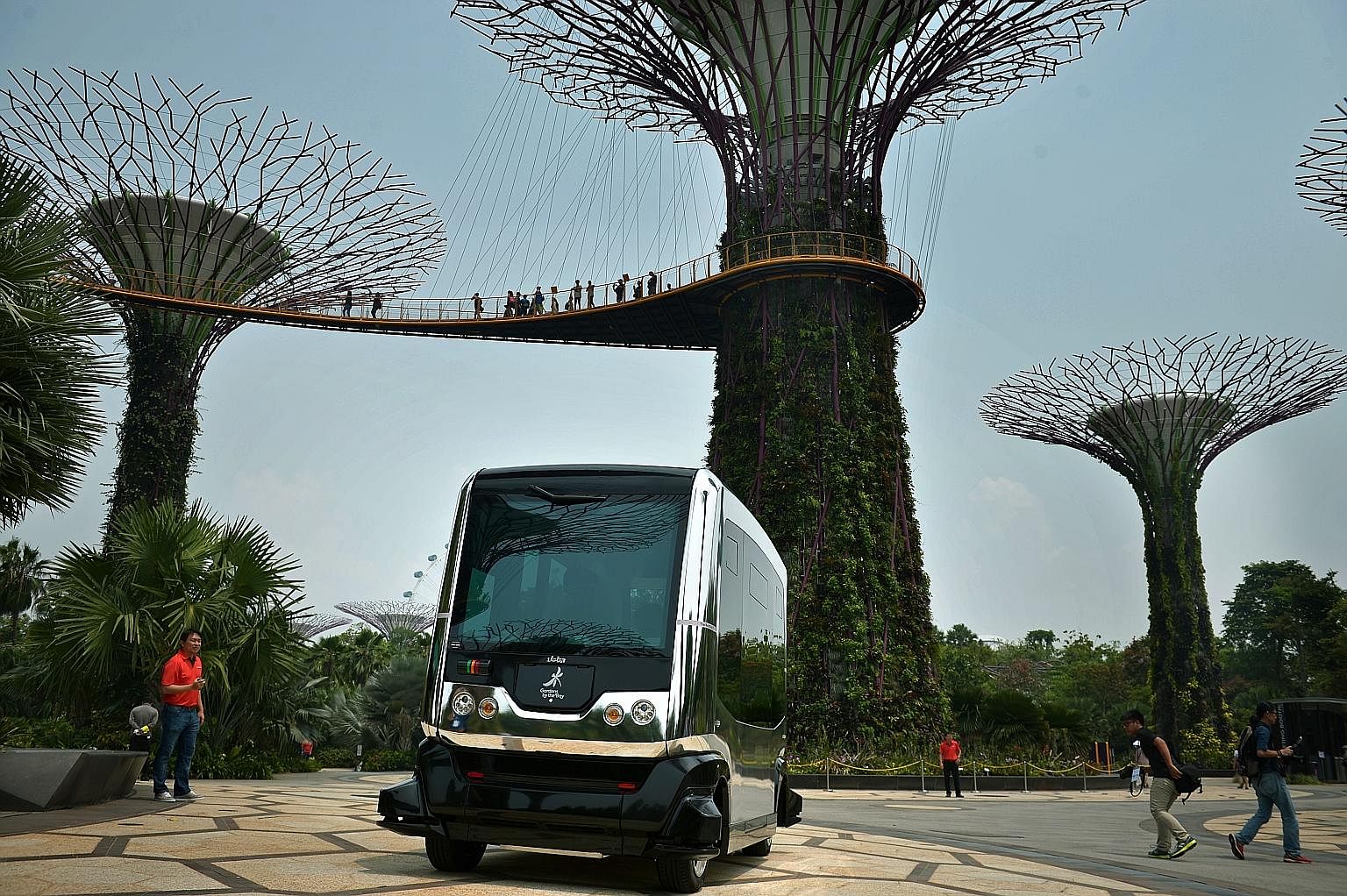Smart, self-driving vehicles may have been the stuff of science fiction in the 1980s, such as in the TV show Knight Rider, but they are now on the road to becoming an everyday reality.
Around the world, tech firms and automakers are in a race to make driverless technology safer and more intelligent, so that their autonomous vehicles (AVs) can function as well, or even better, than their human-driven counterparts.
In Singapore, the AV revolution is being hailed as the next wave in public transportation, with driverless taxis and buses expected to start making an impact here within the next five years.
From late 2020, commuters could find themselves riding on one of two 40-seater self-driving buses to get around their HDB estate.
This is the target outcome of a partnership between the Land Transport Authority (LTA) and ST Kinetics, announced just last month , to jointly develop and trial the autonomous buses.
Companies nuTonomy and Delphi Automotive Systems are also working with the LTA to launch self-driving taxi services on a large scale soon.

With research and business interests in the US and Singapore, nuTonomy plans to have a limited commercial service by next year, with up to 75 vehicles available in selected areas, and services rolled out islandwide by 2020.
-
About The Big Quiz
-
 Each Monday, the paper's journalists will address burning questions in the Opinion section, offering unique Singaporean perspectives on complex issues.
Each Monday, the paper's journalists will address burning questions in the Opinion section, offering unique Singaporean perspectives on complex issues.These primers form part of the outreach of The Straits Times-Ministry of Education National Current Affairs Quiz, or The Big Quiz, which aims to promote an understanding of local and global issues among pre-university students.
Underpinning this year's quiz is a focus on disruption, a timely issue as various sectors and industries adapt to this global change.
The theme was featured in six campus talks helmed by editors and correspondents. Six quiz rounds were also held for students to demonstrate their current affairs knowledge.
The nationwide event is jointly organised by The Straits Times and the Ministry of Education, with the Singapore Press Holdings Foundation as its presenting sponsor.
• For more information or to view additional resources, go to https://www.straitstimes.com/tags/the-big-quiz
• For more information related to the topic, go to: http://str.sg/46YB
The UK-based Delphi, on the other hand, wants to have a fleet of 40 to 50 self-driving taxis by 2022.
Transport Minister Khaw Boon Wan said in January that the Government expects self-driving technology to be mature enough for "widespread deployment" in 10 to 15 years' time.
Autonomous vehicles have the potential to transform public transport, Mr Khaw said in a written parliamentary reply when asked by MP Fatimah Lateef in January for an update on their impact.
Giving an example, Mr Khaw said: "Self-driving pods or shuttles can be deployed at the neighbourhood level to further improve the first and last mile of a public transport journey.
"Commuters can summon these vehicles using their smartphones, and the vehicles will take them in air-conditioned comfort from their doorsteps to the train station," he said, adding that such driverless vehicles will be useful for the elderly, families with kids, and the less mobile.
The future looks bright. But is the mass adoption of self-driving vehicles a pipe dream, or will it become reality?
A BUMPY ROAD AHEAD
In October last year, a self-driving car from nuTonomy collided with a human-driven lorry while undergoing tests in the one-north district, in what was believed to be the first mishap in Singapore involving an autonomous vehicle.
While no one was hurt in the incident, it sparked concerns about the safety of driverless technology.
Following investigations, nuTonomy said the accident was caused by "an extremely rare combination of software anomalies", which affected how the vehicle detected and responded to other nearby vehicles when changing lanes.
It has since improved its software system and resumed trials without incident. Earlier this month, nuTonomy announced a partnership with automaker Groupe PSA in France to install its sensors and computing systems in customised Peugeot vehicles. This will provide seamless integration of AV software with current vehicle hardware.

There have been a few reported accidents elsewhere.
In May last year, 40-year-old Joshua Brown was killed in Florida after his Tesla, which was on "Autopilot" - a driver-assist mode with automatic acceleration, steering and braking functions - smashed into a tractor trailer.
Safety regulators later cleared Tesla's "Autopilot" system of fault, and in their findings said that Mr Brown ignored Tesla's warning to maintain control even while the car was in such a mode.
Tesla said the driver and the car's Autopilot failed to distinguish the white side of the trailer against a bright sky in the accident.
The firm said it has improved its systems, with greater reliance on radar than on cameras, and has incorporated safety features to disable Autopilot when drivers are not paying attention.
THE FUTURE IS HOPEFUL
Despite these incidents, developers and researchers of self-driving cars believe that when the technology is fully mature, these vehicles will be safer than human-driven ones.
This is because of the untapped potential of artificial intelligence, particularly in the area of "deep learning", in which computers mimic a human brain's ability to recognise patterns in huge data sets and make predictions.
This will allow self-driving cars to better deal with the myriad scenarios on the roads, such as deciding when to drive through a road intersection without traffic lights, for example, or predicting the behaviour of other motorists and pedestrians.
Researchers also expect the hardware which helps autonomous vehicles to "see" to become more sophisticated.
Currently, self-driving technology relies on Lidar (Light Detection and Ranging) sensors and smart cameras. Lidar uses laser beams to map out the surrounding environment and objects, while the camera scans for traffic lights, road markings and pedestrians.
The technology is still evolving - two months ago, scientists at the Nanyang Technological University (NTU) unveiled an ultra-fast camera that mimics the human eye.
It can track minute changes in the scene viewed, even in low light, and has applications for self-driving cars and drones.
As technology matures, the LTA is also ramping up its regulatory oversight.
A 1.8ha AV test circuit, located just outside NTU, is expected to be ready in the second half of this year. The facility will be used to test and certify self-driving vehicles in a simulated environment.
The test circuit, which is part of a Centre of Excellence for Testing & Research of Autonomous Vehicles (Cetran) funded by the Land Transport Authority (LTA) and JTC, in partnership with NTU, will have slopes, roundabouts and a section which simulates rainfall.
THE CASE FOR AVs
Globally, around 1.3 million people die in traffic accidents every year. According to studies, over 90 per cent of road accidents are the result of human error arising from poor decision-making, distraction and fatigue.
Scientists tout driverless technology as the antidote to this, as computers never get weary or distracted and, more importantly, are not prone to road rage or erratic behaviour.
These are solid grounds for why money and effort should continue to be poured into the research on self-driving technology, despite the occasional setbacks.
The question then is not whether AVs are the future, but when they can fully replace human-driven private cars, buses, taxis and commercial vehicles. Optimists reckon that this can happen in a decade, but more conservative camps say that it will take at least another 50 years.
But when the time comes, will people be ready for the change?
A Deloitte study of 17 countries - including the US, Germany, China, and Japan - found that consumers are still sceptical of the safety of AVs. Published in January, the report found that as many as 79 per cent of consumers in Japan believe that fully autonomous vehicles will not be safe.
Researchers and automakers thus have an uphill task in getting the buy-in of the public to put their lives in the hands of self-driving vehicles.

